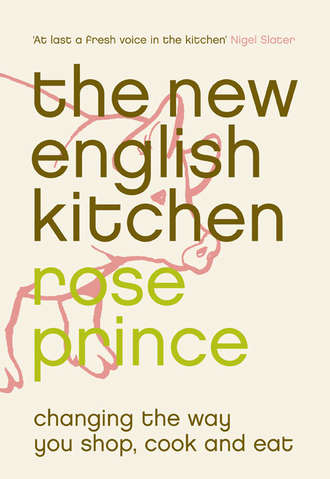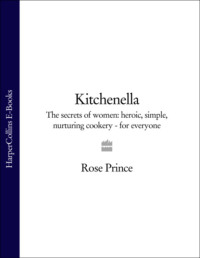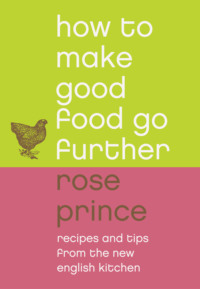
Полная версия
The New English Kitchen: Changing the Way You Shop, Cook and Eat
Busy people swear by their bread machines. They can do the whole job for you, or be set to stop when the dough is ready so it can be shaped and cooked in a conventional oven. Beware of the manufacturer’s recipe books. Some of them include recipes that are simply aping the factory process, with too much yeast and milk powder so the bread will be big and soft. Use traditional recipes instead, using the quantities given in the manufacturer’s recipe book as a guide, and you will be very pleased with what a bread machine can do.
kitchen note
Look for used Kenwood mixers in local papers and car boot sales – a heavy old one with a good motor will go on for years.
the cost of bread
At the time of writing, I buy flour in bulk and it costs me approximately 50 pence to make a loaf, plus negligible costs for yeast, oil and oven power. A loose calculation based on baking four good-quality loaves a week shows that I can save up to £312 a year on buying bread of comparable quality – money for treats.
buying flour
I used to be hopeless at making scones. When I worked at the bakery, we threw away more scones than we sold because they were always dry, weighty and crumbly. Twenty years later I nibbled a sample scone from a stall at a farmers’ market. Light and chewy, without a hint of dryness, this was the scone we were never able to make in the bakery. The stall-holder, slightly taken aback by the passionate interrogation I inflicted on her, casually remarked, ‘Oh, it’s the flour.’ She bought her flour from Cann Mills, a local water mill in Dorset. She did not know why it was so good, it just was.
I wanted to know more, so I visited the mill. The miller, Michael Stoate, took up the story of good wheat flour, the type most commonly used for making bread, scones and cakes. The modern milling industry rolls the grain to remove the bran, taking out the wheatgerm and the flour’s natural oil as it does so. This also removes a vital source of vitamins, which means that they have to be added back to the flour artificially. The wheatgerm oil is very valuable to the pharmaceutical industry, which puts it into creams to go on the outside of our bodies – oh, the irony of it. What’s more, commercial bakers need not mention that it is missing from the flour. About 70 per cent of the bread bought in the UK is made from roller-milled white flour. That is a scandalous amount of missing wheatgerm from what most of us presume is a wholefood.
Stoneground flour, whether white or brown, still contains the wheatgerm – the white flour is simply sifted to remove the bran. Michael Stoate uses millstones to grind all his flour, including the white flour that was used in those scones, with their delightful texture. Traditionally milled stoneground flour can be bought direct from mills, and in some cases delivered to your home (see the Shopping Guide). Look also in specialist independent food shops, farm shops or farmers’ markets, and on the internet. Some supermarkets stock British flour from traditional mills, but do check the label carefully.
Store flour in a sealed bin to keep out pests, or buy it in smaller bulk bags of about 5 kilos that can be sealed between use.
Bread baked in tins or shaped into high rounds needs strong flour, made from ‘hard’ wheat species. These contain a greater amount of glutenin and gliadin, essential for the bread to rise well and form a nice, elastic crumb. In the past, hard wheat was grown mainly in North America for the British bread industry, but with selective breeding it has been adapted over the last few decades to grow well in British conditions. Do not confuse strong flour with hard durum wheat flour, or semolina, which is used specifically for pasta making.
Soft wheat flour, sold as plain flour, is suitable for cake and pastry making and can also be used for soda bread and scones.
other types of flour
While the gluten in wheat flour is vital for the standard bread recipe, a percentage of another type of cereal flour can be added for variety, such as rye, barley, buckwheat or oats. These cereals, however, contain little gluten, and yeast bread made with rye, barley or oat flour alone will be heavy, and does not keep well. Alternative types of flour, made from vegetables like chick peas or potato, are more useful in other forms of cookery. There are recipes using these flours (here.
yeast
Fast-action, or easy-blend, yeast is now the most widely available type. It can be mixed straight into the flour, speeding up breadmaking by about half an hour. Conventional dried yeast, sold loose in tins, should be used in the same quantity but must be dissolved in warm water first. Compressed or fresh yeast is not always easy to find now. The best places to try are independent bakeries and some health-food shops. It should be dissolved in warm water or milk before adding it to the dry ingredients. If substituting fresh yeast for dried, you will need double the quantity stated in the recipe.
a little bread science
The breadmaking process is easier to understand once you know a little piece of molecular chemistry. Yeast gives dough its oomph, but it needs gluten to do so. Live yeast makes bubbles of carbon dioxide in the soft, elastic dough. The legend of the first yeast goes that a cook left a piece of dough near a vat of beer and some of the wild yeasts from the ale got into the dough. The cook noticed the bubbles in the bread – the rest is history.
When water comes into contact with flour, it swells the proteins in it. Kneading the dough by hand or machine allows these proteins to blend, changing the molecular structure and forming the all-important gluten.
You must choose if you want to add fat to your bread. Fat improves bread’s keeping qualities and gives it a denser texture. It can, however, prevent the dough becoming soft and elastic if it is rubbed into the flour before the water is added, because this delays the essential formation of gluten. Gluten is to dough what steel frames are to skyscraper construction. Its strength allows large spaces of air to form and hold within the dough. The best way to get bread going quickly is to add fat after the water. I do this by oiling the bowl that holds the dough as it rises, then mixing it in before the bread is shaped.
It is fine to leave fat out of bread; it simply results in a lighter dough with large bubbles. If you make small quantities of bread frequently, or rolls, there is no real need to add fat.
Two things kill yeast: too much salt, and heat. Don’t be too free with salt – follow the amount specified in recipes until you get to the stage where experience teaches you how much to add. And don’t leave the dough to rise anywhere too hot, such as on a radiator or beside a fire. In fact, bread doesn’t have to be left in a warm place to rise at all, and will even rise perfectly happily – though slowly – in the fridge. The important thing is that it should be in a draught-free place.
how to knead bread by hand
Take the dough, which will still be sticky, out of the bowl and place it on a floured work surface. Use both hands to pull and stretch the bread, folding it back on itself, pulling and stretching again, giving it a quarter turn each time. Persevere for several minutes – 15 is best. The process helps the gluten develop, making the dough silky, soft and elastic. Be robust when kneading – you can be as aggressive as you want, since it will speed up the process.
basic yeast bread
This recipe works well in a food mixer and can be used for the classic, rectangular tin loaf or for any other shape. Strong white flour, malted wheat, wholemeal or a mixture all work well.
Makes 2 small loaves
700g/1 1/2lb flour
2 x 7g sachets of fast-action (easy-blend) yeast
1 heaped teaspoon fine salt or 2 teaspoons soft sea salt crystals
1 heaped teaspoon unrefined sugar
425ml/14fl oz water, at blood temperature
1 tablespoon vegetable or olive oil (optional – see here)
Put the flour in a large bowl with the yeast, salt and sugar and stir until combined. Make a well in the centre and add the warm water, stirring all the time until the ingredients form a sticky dough. Continue to knead the bread – by hand (see above) for 15 minutes, or for 5 minutes on the slow setting of a food mixer fitted with a dough hook. If the dough is too sticky, add more flour; if it is too dry, work in a little water.
The dough will become smooth and elastic as the gluten forms. When you have finished kneading it, put it into an oiled bowl (if you are using the oil), cover with a cloth and leave in a warm, draught-free spot for 1 1/2–2 hours, until doubled in size (or leave for longer at cool room temperature, or overnight in the fridge).
Knock the air out of the dough, kneading the oil into it. Prepare two 480g/1lb loaf tins by brushing all over the inside surface with a little oil. Divide the dough in half, shape each piece into a fat sausage and put into a tin or make 2 rounds and place each in the centre of a baking sheet. Scatter flour on top, cut a slash lengthways down the centre with a sharp knife and leave to rise again, uncovered, for 20–30 minutes. Preheat the oven to 230°C/450°F/Gas Mark 8.
Bake the loaves for 30–40 minutes. They are ready when they come easily out of the tin and sound hollow when tapped on the base with a finger.
kitchen notes



more adventures with dough
Once you are hooked on making bread at home, it is easy to adjust the recipe or substitute different flours and ingredients. I am not crazy about adding olives, Parmesan, sun-dried tomatoes or fried onions to bread – I’d rather eat those things another way – but working fresh herbs or aromatics into the dough does have a good effect. A few chopped rosemary leaves or sage make a nice savoury bread. Steeping some saffron threads in the warm liquid before you add it to the flour makes a beautiful saffron-scented loaf, delicious with dry-cured meats and fresh cheeses.
To make tea bread, set aside a piece of dough and roll it into a rectangle. Scatter over a little brown sugar and some chopped dried fruit (figs, raisins, prunes or apricots), then roll it up into a Swiss roll shape. Either brush it with beaten egg and bake whole, or cut it into slices to make Chelsea buns, lay these on a greased baking sheet, brush with egg and bake. Scatter some golden caster sugar on Chelsea buns when they come out of the oven.
Substituting milk for water in your dough will make a softer, sweeter tea bread.
sourdough bread
Sourdough bread is a treat to buy from a specialist baker and can be eaten fresh or used in recipes. I admit I often beg mine from my sister and brother-in-law, Sam and Sam Clark. With apologies to the late M. Poîlaine, creator of the famous sourdough loaf, pain Poîlaine (see the Shopping Guide), and, honestly, no sibling conspiracy, I believe their experiments at their restaurant, Moro, have resulted in the absolute best there is. A recipe for it is given in Moro – The Cookbook (Ebury, 2001).
Slow fermentation of the yeast in bread makes a sour dough. You can make your own yeast, beginning with a combination of flour and fruit juice and ‘feeding’ the bacteria, but there are simpler methods for home kitchens. Leaving the dough to rise overnight in the fridge, rather than giving it a quick rise in a warm place, produces a more sour dough. You can also knead into it a piece of dough left over from breadmaking a few days earlier (keep it in the fridge, wrapped in cling film; it will sour as it matures). When you make your bread, use only half the yeast specified in the recipe and work the older dough into the new. Allow your dough to rise in the fridge either overnight or during the day. Once baked, the bread will have a full, ripe, savoury taste and the scent of toasted nuts. It will have a strong, tactile crumb, and larger bubbles even if you have used fat. There is no doubt at all that the inner crumb of sourdough keeps its elasticity longer. Nor will the flavour diminish as it ages: old sourdough bread will be as good eaten fresh as it is in your cooking.
soda bread
If you don’t have any yeast, or prefer not to eat it, soda bread is a wonderful quick standby and the best bread to eat, buttered, with smoked fish or pastrami. While yeast comes to life with the changing temperature and moisture in the dough, bicarbonate of soda reacts with sour milk or buttermilk, making bubbles that raise the dough and set when baked.
480g/1lb wholemeal flour (or a 50/50 mix of white and wholemeal
flour for a paler loaf)
1 teaspoon fine oatmeal
11/2 teaspoons fine salt
11/2 teaspoons bicarbonate of soda
30g/1oz butter
500ml/16fl oz sour milk (see Kitchen Note overleaf) or buttermilk
(or low-fat yoghurt)
Preheat the oven to 230°C/450°F/Gas Mark 8. In a large bowl, mix together the flour, oatmeal, salt and soda, then rub in the butter. Make a well in the centre and slowly add the liquid, mixing all the time. Work the flour in using your hand, until you have a soft but not sticky dough. Turn it out on to a board and shape lightly into a smooth round. Place on a greased baking sheet, scatter with a little extra flour and cut a deep cross on the top with a sharp knife. Bake for 30–35 minutes, turning down the heat to 200°C/400°F/Gas Mark 6 halfway through. The loaf is ready when the base sounds hollow when tapped with a finger. If the loaf is soggy underneath, bake it upside down for a further 5 minutes.
kitchen notes


savoury pan scones
Try to find stoneground white flour for these scones; it will give them a lovely chewiness. A really heavy-based frying pan or flat griddle is essential if you cook them on the hob, otherwise they’ll burn.
The nicest way to eat pan scones is while they are still warm, halved and buttered.
Makes 8–10 scones
480g/1lb plain flour
1 teaspoon bicarbonate of soda
1 teaspoon cream of tartar
2 teaspoons salt
90g/3oz beef dripping (see here) or butter (or 6 tablespoons
olive oil)
300ml/1/2 pint sour milk (see above), buttermilk or low-fat yoghurt
Sift all the dry ingredients into a bowl and rub in the fat. Make a well in the centre and stir in the milk, buttermilk or yoghurt to make a smooth dough.
With floured hands, quickly shape the dough into small rounds, 2cm/3/4 inch thick. Heat a heavy-based frying pan or a flat griddle and cook the scones for 4 minutes on each side, until golden and slightly puffed. Alternatively, bake them in an oven preheated to 230°C/450°F/Gas Mark 8 for 10 minutes.
kitchen note
You can play around with the flavour of scones, adding grated or chopped cheese (it’s a good way to use cheese that is no longer presentable on the table). Try to use one of the many interesting British farmhouse hard cheeses. Crumbled pork crackling makes them wickedly delicious, too. Alternatively, try chopped spring onions, dried thyme or rosemary.
drop scones
I include these because they were one of the first things I ever made myself, and because my mother often made them for tea to eat with golden syrup and butter. The ingredients are pure store cupboard, so you won’t have to rush out and buy biscuits on a Sunday when someone drops in for tea. The recipe is from a much-Sellotaped 1950s copy of The Constance Spry Cookery Book – one of my bibles.
Makes about 12
240g/8oz plain flour
1/2 teaspoon bicarbonate of soda
1/2 teaspoon cream of tartar
1/2 teaspoon baking powder
1 tablespoon golden caster sugar
a nut of butter
1 tablespoon golden syrup
about 300ml/1/2 pint milk
1 egg
Mix the dry ingredients in a bowl, then rub in the butter and add the syrup. Add half the milk, mixing well with a wooden spoon. Break in the egg and beat well, then add the remaining milk. The mixture should just drop from the spoon. Allow to stand for 10–15 minutes, not more.
Heat an oiled flat griddle or heavy-based frying pan. When it is moderately hot, drop in the mixture in spoonfuls and cook for 2–3 minutes, until small bubbles appear on the surface. Flip the drop scones over and cook for about 30 seconds to brown the other side. Wrap the scones in a tea towel to keep them warm while you cook the rest, then serve with butter, jam and syrup.
kitchen note
It won’t be necessary to re-grease the pan as you cook each batch; the drop scones are all the better for being cooked without much oil at all.
flat breads
The earliest breads were unleavened – they did not contain yeast. They were rolled or pressed out and baked absolutely flat. The offspring of these ancient flat breads can still be found in the Middle East, where there are hundreds of versions, including breads no thicker than card but floppy enough to wrap around herbs and salty cheese, and slightly thicker, round flat breads, which are put to use as a jacket for kebabs. I remember when pitta bread was considered avant garde, but now flat breads in every guise can be bought from Middle Eastern and Asian shops; even supermarkets sell several versions of flat bread, or ‘wraps’ – a word that came from the United States. There are soft breads such as Indian naan and chapatis or Mexican tortillas, crisp breads like lavash to crumble into soups and salads, or flaky roti to parcel up West Indian curries.
Making flat breads at home is good economics: a batch of up to ten can be made from 360g of good flour, worth less than 50 pence, which comes in at approximately a third of the cost of ten tortilla wraps or pitta breads.
basic flat bread
I cannot even begin to give an authentic recipe for every kind of flat bread but the recipe below, adapted from Tom Jaine’s Making Bread at Home (Weidenfeld & Nicolson, 1995), makes a good, crisp, flat bread that can be broken into soup or a leafy salad, or used to scoop food into your mouth. It uses yeast, but you could use a little dough left over from the previous baking instead for the same lightening effect.
The secret of all flat breads is to rest the dough in the fridge. This gives the gluten time to relax, so that you can roll or press the bread out very flat. It also sours the dough slightly, adding flavour.
Makes 8–10
360g/12oz unbleached strong white flour (or 240g/8oz flour and 180g/6oz stored dough from the last bread)
1 teaspoon salt
7g sachet of fast-action (easy-blend) yeast
240g/8oz low-fat yoghurt
Mix together all the dry ingredients, then stir in the yoghurt. Knead, in a machine or by hand (see here and here), until the dough is smooth and elastic. Cover with cling film and store in the fridge for at least 4 hours, or overnight.
Preheat the oven to 230°C/450°F/Gas Mark 8. Divide the dough into balls the size of a large walnut. Roll out each one on a floured work surface until it is very thin. Place on an oiled baking sheet, allow to rest for 5–10 minutes then bake for 8–12 minutes, until the flat breads are crisp and light golden in places.
kitchen note
You can also make these breads from maize flour (polenta), chestnut flour or gram (chick pea) flour, using them to replace a third of the ordinary flour.
dry flat bread
Bought and home-made flat breads become stale quickly but they can still be worked into other meals. If they are still soft, tear them up, then toast until dry. Alternatively fry gently in olive oil. Store in jars ready for use in salads or soups.
bread salad
Cut or tear a dry or toasted flat bread into postage-stamp-sized pieces. Make a salad with the bread, Cos or romaine lettuce hearts, spinach or other leaves, herbs (parsley and dill), sliced tomatoes – the juice soaks nicely into the bread – and cucumber. Dress with just extra virgin olive or walnut oil and lemon juice, salt and pepper.
pizza margherita
San Gennaro is the patron saint of Naples, the birthplace of spaghetti and that other international fast food, pizza. It is also the name above the door of our local pizzeria in London. We are lucky. At San Gennaro they make pizza in the traditional way, with ingredients from Campania, the region around Naples that is famous for its wheat, tomatoes and buffalo mozzarella. The proprietor, Enzo, operates on Neapolitan hours – the door never opens before 5.30 p.m. and it closes in the small hours. I first walked into this south London pizzeria late one August night. A few people were sitting at the bar drinking small glasses of home-made limoncello. We could have been in Campania itself and that was before we ate the pizza.
Good pizza dough is almost flaky, the air barely held inside, and breaks easily. It has a slight sourness, a faint smoky flavour where it has been charred by the heat of the oven. The secret of this recipe was revealed to me after an evening spent deep in the basement of San Gennaro, watching José make the dough. He refrigerates it overnight, so that it can be stretched to incredible thinness the following day.
‘Anyone can make good pizza,’ says Enzo. ‘You can be from Ecuador, Nigeria or London, but you need two things: authentic ingredients and “the knowledge”.’
Makes 2
4 tablespoons olive oil
8 basil leaves
6 tablespoons Tomato Sauce (see here)
120g/4oz buffalo mozzarella, cut into 1cm/1/2 inch pieces







